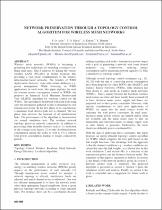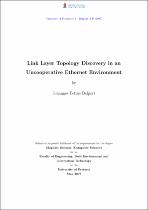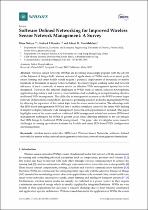 ResearchSpace
ResearchSpace
Network preservation through a topology control algorithm for wireless mesh networks
JavaScript is disabled for your browser. Some features of this site may not work without it.
- ResearchSpace
- →
- Research Publications/Outputs
- →
- Conference Publications
- →
- View Item
| dc.contributor.author |
Aron, FO

|
|
| dc.contributor.author |
Olwal, TO

|
|
| dc.contributor.author |
Kurien, A

|
|
| dc.contributor.author |
Hamam, Y

|
|
| dc.date.accessioned | 2009-07-29T06:51:11Z | |
| dc.date.available | 2009-07-29T06:51:11Z | |
| dc.date.issued | 2008-09 | |
| dc.identifier.citation | Aron, TO, Olwal, TO, Kurien, A and Hamam, Y. 2008. Network preservation through a topology control algorithm for wireless mesh networks. The Second IASTED Africa Conference on Modelling and Simulation (AfricaMS 2008), Gaborone, Botswana, 8–10 September 2008, pp 7 | en |
| dc.identifier.isbn | 603-080 | |
| dc.identifier.uri | http://hdl.handle.net/10204/3513 | |
| dc.description | 2nd IASTED Africa Conference on Modelling and Simulation (AfricaMS 2008) | en |
| dc.description.abstract | Wireless mesh networks (WMNs) is becoming a promising new technology for extending coverage to farflung rural areas. This it achieves by linking the various wireless LANS (WLANs) in distant locations thus providing a vital mode complimentary to the wireless infrastructure-based networks. The benefits of WMN deployments, however, come with certain challenges e.g., power management. While focussing on WMN applications in rural areas, this paper explains the need for transmit power consumption control in WMNs and proposes an Enhanced Local Minimum Shortest-path Tree (ELMST) algorithm for topology control for the WMNs. The algorithm is distributed with each node using only the information gathered locally to determine its own transmission power. In the first phase of its construction, a minimum local shortest-path tree is obtained. The last phase then involves the removal of all unidirectional links. The performance of the algorithm is demonstrated via several simulation tests. The resultant network topology preserves network connectivity in addition to possessing other desirable features such as: (1) reduction in the average node degree, (2) evenly distributed power consumption among the nodes as well as (3) a reduced total power consumption leading to longer connectivity periods. | en |
| dc.language.iso | en | en |
| dc.publisher | 2nd IASTED Africa Conference on Modelling and Simulation - AfricaMS 2008 | en |
| dc.subject | Topology control | en |
| dc.subject | Wireless mesh networks | en |
| dc.subject | Localized algorithm | en |
| dc.subject | Mesh network | en |
| dc.subject | Wireless infrastructure-based networks | en |
| dc.subject | IASTED Africa Conference on Modelling and Simulation 2008 | en |
| dc.subject | AfricaMS 2008 | en |
| dc.subject | Modelling | en |
| dc.subject | Simulation | en |
| dc.subject | Energy efficiency | en |
| dc.subject | Network preservation | en |
| dc.title | Network preservation through a topology control algorithm for wireless mesh networks | en |
| dc.type | Conference Presentation | en |
| dc.identifier.apacitation | Aron, F., Olwal, T., Kurien, A., & Hamam, Y. (2008). Network preservation through a topology control algorithm for wireless mesh networks. 2nd IASTED Africa Conference on Modelling and Simulation - AfricaMS 2008. http://hdl.handle.net/10204/3513 | en_ZA |
| dc.identifier.chicagocitation | Aron, FO, TO Olwal, A Kurien, and Y Hamam. "Network preservation through a topology control algorithm for wireless mesh networks." (2008): http://hdl.handle.net/10204/3513 | en_ZA |
| dc.identifier.vancouvercitation | Aron F, Olwal T, Kurien A, Hamam Y, Network preservation through a topology control algorithm for wireless mesh networks; 2nd IASTED Africa Conference on Modelling and Simulation - AfricaMS 2008; 2008. http://hdl.handle.net/10204/3513 . | en_ZA |
| dc.identifier.ris | TY - Conference Presentation AU - Aron, FO AU - Olwal, TO AU - Kurien, A AU - Hamam, Y AB - Wireless mesh networks (WMNs) is becoming a promising new technology for extending coverage to farflung rural areas. This it achieves by linking the various wireless LANS (WLANs) in distant locations thus providing a vital mode complimentary to the wireless infrastructure-based networks. The benefits of WMN deployments, however, come with certain challenges e.g., power management. While focussing on WMN applications in rural areas, this paper explains the need for transmit power consumption control in WMNs and proposes an Enhanced Local Minimum Shortest-path Tree (ELMST) algorithm for topology control for the WMNs. The algorithm is distributed with each node using only the information gathered locally to determine its own transmission power. In the first phase of its construction, a minimum local shortest-path tree is obtained. The last phase then involves the removal of all unidirectional links. The performance of the algorithm is demonstrated via several simulation tests. The resultant network topology preserves network connectivity in addition to possessing other desirable features such as: (1) reduction in the average node degree, (2) evenly distributed power consumption among the nodes as well as (3) a reduced total power consumption leading to longer connectivity periods. DA - 2008-09 DB - ResearchSpace DP - CSIR KW - Topology control KW - Wireless mesh networks KW - Localized algorithm KW - Mesh network KW - Wireless infrastructure-based networks KW - IASTED Africa Conference on Modelling and Simulation 2008 KW - AfricaMS 2008 KW - Modelling KW - Simulation KW - Energy efficiency KW - Network preservation LK - https://researchspace.csir.co.za PY - 2008 SM - 603-080 T1 - Network preservation through a topology control algorithm for wireless mesh networks TI - Network preservation through a topology control algorithm for wireless mesh networks UR - http://hdl.handle.net/10204/3513 ER - | en_ZA |







